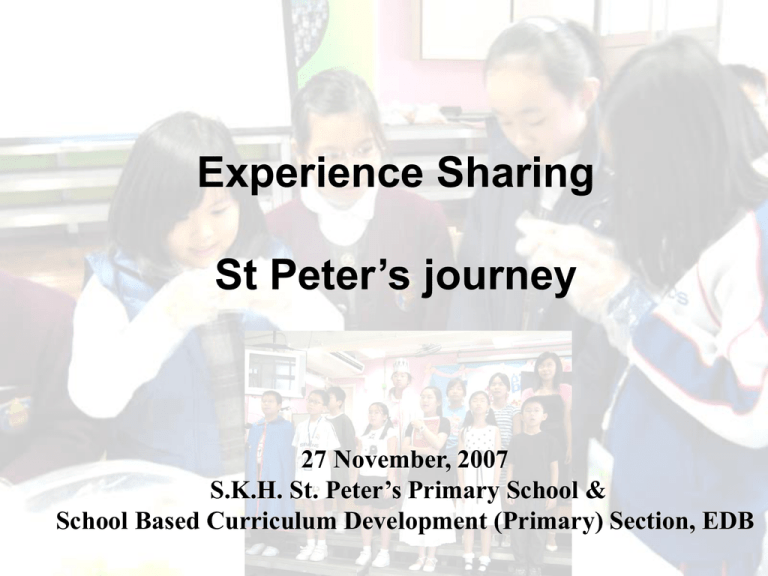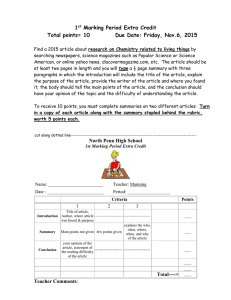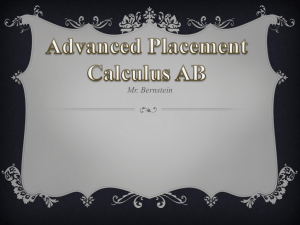Experience sharing on using assessment data to enhance learning and teaching (2)
advertisement

Experience Sharing St Peter’s journey 27 November, 2007 S.K.H. St. Peter’s Primary School & School Based Curriculum Development (Primary) Section, EDB 1 Challenges to our students in reading nowadays • Questions that require them to read into details • Questions that require them to look for main ideas by drawing information from several places in the text • Questions that require them to analyse • Questions that ask about intentions, attitudes, feelings • Questions that require them to think …. 2 Building language skills in our daily learning and teaching schedule 3 A comprehensive idea of book concept ~ Locating information provided on the book cover, on the spine or blurb, index and glossary. 4 A comprehensive idea of book concept ~ Locate information provided on the book cover, on the spine or blurb, index and glossary. 5 Working out unfamiliar words ~ Predicting speakers’ feelings and intentions ~ “… the rat to nibble with her sharp front teeth.” (paragraph 2, p.4) To nibble means … A. to hold the food. B. to play with the food. C. to take the whole piece of food at a time quickly. D. to eat the food with small bites. What is the meaning of ‘as usual’ in the sentence ‘Mum is happy as usual.’ on P1? A before B after C always D now On P4, Grandma says, ‘What a mess!’ Do you think she is happy? A yes B no 6 Locating information and ideas from a biography Complete the fact file based on the biography in Part C. Real name: _________________________ Pen name: _________________________ Job: _____________ Age: ___________________ Place of birth: _______________ Important times / events / achievements: _____________: born in England Childhood: studied in _____________________________; wrote her first story about ______________; liked _____ing At her 20’s: studied in ___________________________________ First book: name--“___________________________________”; about a boy studying in _____________________ ____________________________________________; image of this boy appears in her mind when she was travelling on a ___________; 1994: wrote her book in a _______________; later published by _______________________; 1997: won her the first award: ______________________ ____________________________________________; 1998: ____________________ began to make the Harry Potter books into films 7 Locating information and ideas from a story Character Snapshots What characters are in your story? Use this character snapshot table to help you describe the characters. Characters Appearance/ Personality What happened to them? 8 Teach them the way to read … •Train them the ways to work out the meaning of unfamiliar words or expressions by using contextual clues or pictorial cues. •Most importantly, they need to have the right attitude when dealing with this kind of questions •Get students think more during class time 9 Skimming and Scanning Techniques Skim a text to get the gist and main idea. 10 Skimming and Scanning Techniques Scan for specific information.11 Reading exposure – Balance intensive and extensive reading Are the text types well covered in each modules, at each Key Stages, throughout the whole year? Do your student benefit from the extensive reading scheme? Is there room for improvement especially when it comes to monitoring the practice Have they been reminded that reading can be done any time and anywhere? (Look at the signs around us, look at the advertisement on the street, look at the bar of chocolate you are eating, etc) 12 Delivery of those language skills during lessons How reading skills are taught to students 13 Catering for learner differences 14 Cater for Learner Differences – Different sets of materials Creative writer booklet for more Creative writer booklet for able students—with an the majority of students additional page for each topic 15 Cater for Learner Differences – Help cards given to students • Hints provided to facilitate the speaking activities 16 Cater for Learner Differences – Bilingual notes to parents • Help explain the school’s English language policies to parents and solicit their support 17 Cater for Learner Differences – Split classes to form an additional English class • Small group learning for slow learners 18 Challenges to our students in writing nowadays lack of elaboration short of ideas lack of variety or creative expression in guided writing limited vocabulary inappropriate diction (choice of words) syntactical problems (not enough understanding of what a sentence is) Sometimes, direct translation from Chinese to English e.g. I can do your friend. The lion wants to eat the mouse. The mouse is afraid. The mouse is lion friends now. 19 Integrating Writing Strategies into the Curriculum 20 I’m a creative writer! Topic Theme Genre Target structure Someone I like People and family description Present tense, adjectives of characters School picnic School life narration Past tense, verb forms Christmas festivals narration Past tense My feelings before examinations Feelings, school life expressive, explanatory Adjectives of feelings, futurity How I use my lucky money Daily life, festivals expository, imaginative Quantifiers, adjectives My favourite sport hobbies description Present tense, preferences, reasons A riddle riddle expository, informal Adjectives, body parts, questions My plans for the future plan expository Futurity, predictions 21 I’m a creative writer! 22 I’m a creative writer! 23 Quality Marking • Use different marking methods and subject-specific marking criteria in line with the focuses and emphases within the learning targets set for the assessment tasks • Do NOT confine marking to ticks, crosses, marks and grades (A tick marked with the word 'good' only does NOT tell the student why the work is good or what criteria it fulfils) • Try to provide explanatory comments (which are timely and concise and inform students about why something is good or less good) 24 Quality Marking • Agree guiding principles among panel teachers as to the methods, frequency and amount of assessment and ways for marking based on professional judgment • Detailed marking is desirable but schools cannot expect teachers to mark every single piece of student work in a detailed way, nor is it necessary for them to do so in view of their manageability and workload 25 Make a biography using a can. This time you will try to write not on a piece of paper, but on a can! Think of a famous you like. Write a biography for him or her. Instructions: 1.Find a can of soft drinks. 2.Enjoy the drink. 3.Wash the can and let it dry. Cut long slices of drawing paper. 1.Join the slices together with tape. 2.Stick the end of the slice to the can. 3.Roll the paper on the can. 4.Write on the can with colour pens. 5.Print photos or draw pictures of the famous person. Stick them onto the paper. 6.Show the can to your friends and read your biography to them. Peer editing: Help your partner to check the followings Language Organization Correct use of tenses Past Tense Make sure the writing: 1.iswill arranged according to the of the Your scroll be marked based on order the following criteria: events Connectives 2.includes important events Organization /20 Correct use of 3.includes Ending Statement to comment Content /50 First”, “Then”, “Next”, “After that” and “Finally” the person Language /20 Style /10 Total 26 /100 Setting up a common marking criteria Score Very Competent Competent Fairly Competent Needs more Effort Content Language Organisation Punctuation 45 – 50 -Provides relevant information and interesting ideas -The overall meaning is clear 16 – 20 -Ideas are communicated clearly and coherently, with few errors in vocabulary, grammar or spelling -Uses a good range of vocabulary and sentence structures 16 – 20 -Ideas are clearly and logically organized -Includes a.arranged according to the order of the events b.important events c.comment of the person 8 – 10 -Few errors in using punctuation marks -Few errors in capital letters 30 – 44 -Provides some relevant information -Some effort is required to understand the overall meaning 8 – 15 -Ideas are communicated clearly, with some errors in vocabulary, grammar or spelling -Uses a reasonable range of vocabulary and sentence structures 8 – 15 -Ideas are generally clearly and logically organized -Includes any 2 of the followings: a.arranged according to the order of the events b.important events c.comment of the person 4–7 -Some errors in using punctuation marks -Some errors in capital letters 15 – 29 -Provides mostly irrelevant information but makes some attempt to write -The overall meaning can be understood but with considerable difficulty 2–7 -Ideas are ineffectively communicated, with frequent errors in vocabulary, grammar or spelling -Uses a limited range of vocabulary and sentence structures 2–7 -Ideas are not clearly and logically organized, thus impeding comprehension -Includes 1 of the followings a.arranged according to the order of the events b.important events c.comment of the person 1–3 -Frequent errors in using punctuation marks -Frequent errors in capital letters 0 – 14 -Provides totally irrelevant information or makes no attempt to write -The meaning is unintelligible 0–1 -Comprehension is seriously impeded by constant and significant errors in vocabulary, grammar or spelling -Uses a very limited range of vocabulary and sentence structures 0–1 -Ideas are muddles and incomprehensible -Doesn’t include any of the followings a.arranged according to the order of the events b.important events c.comment of the person 0 -Significant errors in using punctuation marks -Significant errors in capitals Detailed descriptors Target structures are expected Comments can be derived from this Marks awarded according to the spectrum fallen27in Teacher feedback to students 28 Teacher intervention and student response at the brainstorming stage 29 More feedback samples from other schools 30 Connecting Formative Assessment and Feedback with Learning • Involve students in self-assessment (selfchecking, peer feedback) • Help students to know themselves and the standards they should attain (show them both good and bad examples) • Celebrate achievement, enhance motivation, build self-esteem 31 How do you organise the writing in the curriculum? – Have students got adequate inputs in the module? – Do these inputs help to build up their productive skills? – Are they provided with an authentic context to write? – Is time being given to them to enjoy the writing process ? – Are constructive feedbacks provided at different stages of writing? 32 From 2003 - what are we up to now? While realizing the objectives suggested in the English language curriculum guide, we help students get prepared for standards required in TSA While enhancing students’ language skills and generic skills in the modules, we bear in mind that meeting Basic Competency Descriptors is important. While implementing reading workshops, we train more able students to read high order thinking questions and support the struggling ones with achievable tasks While designing writing tasks for students, we keep in mind that our students nowadays need more exposure to different text types 33 In face of the rapidly developing media world. You’re welcomed to contact us: Dr Ernest TSE 21584930 Ms Jeanda FUNG 21584924 34 35

